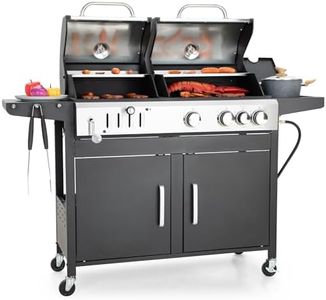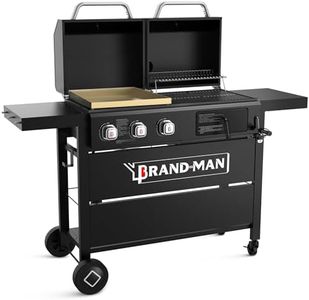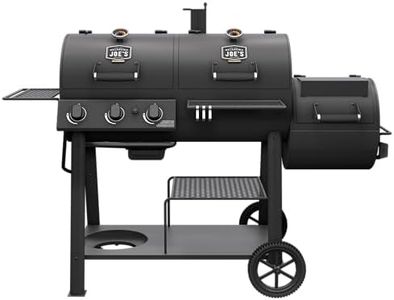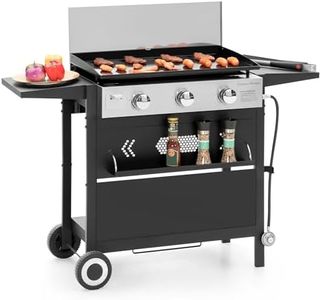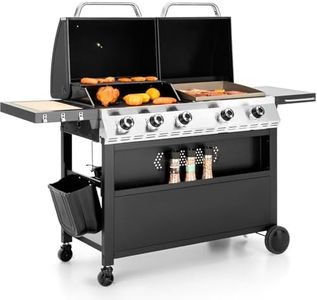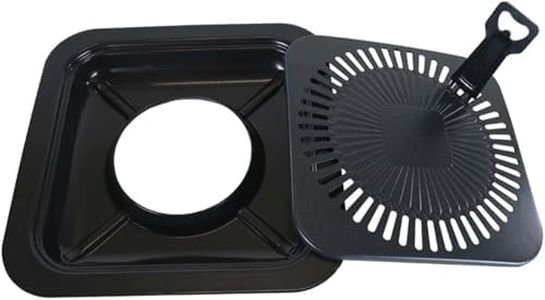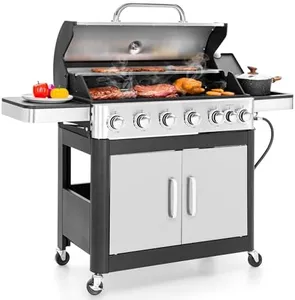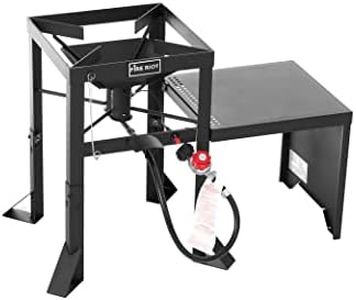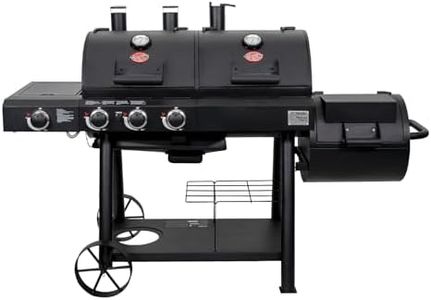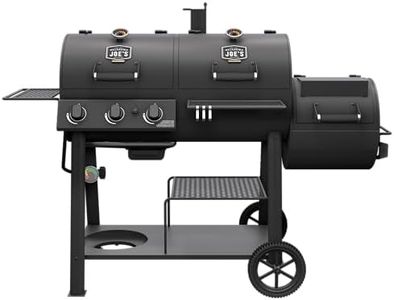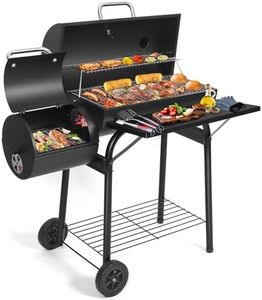10 Best Combination Grills Gas And Charcoal 2025 in the United States
Our technology thoroughly searches through the online shopping world, reviewing hundreds of sites. We then process and analyze this information, updating in real-time to bring you the latest top-rated products. This way, you always get the best and most current options available.

Our Top Picks
Winner
Captiva Designs Propane Gas Grill and Charcoal Grill Combo with Side Burner & Porcelain-Enameled Cast Iron Grate, Dual Fuel BBQ Grill for Outdoor Events & Backyard Barbecue, 690 SQIN Cooking Area
Most important from
712 reviews
The Captiva Designs propane gas and charcoal combo grill is a versatile option for those who want the convenience of gas grilling alongside the authentic flavor of charcoal. It offers a large cooking area of 690 square inches, split between a 520 sq.in. porcelain-enameled cast iron grate and a 170 sq.in. warming rack, which is generous enough for family gatherings or small parties. With three main burners producing a heating power of 11 kilowatts, it provides solid temperature control for the gas side, while the charcoal side lets you enjoy traditional grilling. The porcelain-enameled cast iron grates are a nice touch, combining durability, nonstick properties, and rust resistance to ensure even heat distribution. The grill also includes a side burner, adding flexibility for cooking sides or sauces. Cleaning is made relatively easy with full-sized, slide-out grease and ash trays designed to catch drippings and residue efficiently.
The build uses a mix of alloy steel, stainless steel, and cast iron, giving it a sturdy feel, though assembly is required, and some users may find setup a bit challenging. Features like a built-in thermometer, tool holder, warming rack, and locking casters add convenience and mobility. This grill offers dual-fuel options and a large cooking surface, but it is a bit on the bulky side, so having sufficient outdoor space is important. For those wanting the flexibility to switch between gas and charcoal without buying separate grills, this model fulfills those needs well, especially for casual backyard cooks who appreciate ease of use and straightforward maintenance.
Most important from
712 reviews
Sophia & William Charcoal and Propane Gas Grill Combo with Side Burner & Porcelain-Enameled Cast Iron Grate, Dual Fuel BBQ Grill for Outdoor, Barbecue Grill, 690 SQIN Cooking Area
Most important from
522 reviews
The Sophia & William Charcoal and Propane Gas Grill Combo is a versatile option for outdoor cooking, offering both gas and charcoal grilling in one unit. This flexibility lets you enjoy the smoky flavor of charcoal or the quick, easy heat control of gas, which is great for cooking different foods simultaneously with its separate zones. The 690 square inches of cooking space, including a large primary area and a warming rack, can comfortably handle meals for gatherings or parties. Its porcelain-enameled cast iron grates are durable, rust-resistant, and help spread heat evenly, avoiding hot or cold spots during cooking.
At 11 kilowatts, the gas burners provide solid heating power, and the included side burner adds extra cooking versatility. The grill is built with alloy steel and features a non-stick, rust-resistant finish, plus locking casters for stability and mobility. Cleaning is made easier with a removable ash tray for charcoal ashes and a slide-out grease tray for gas drippings, which helps reduce mess and maintenance time. However, assembly is required, which might take some time if you’re not used to building grills. Also, while the grill offers solid temperature control on the gas side, charcoal temperature management depends on your skill, which is common for combo grills.
Weighing 47 pounds, it’s reasonably portable but may need two people for moving. This grill is ideal for outdoor enthusiasts who want both fuel options and ample cooking space without opting for a very expensive model. If you want a reliable dual-fuel grill with good build quality and useful features, this product delivers a practical balance, though it might not include some of the high-end extras found in more premium combos.
Most important from
522 reviews
3 Burner Propane Gas and Charcoal Grill Combo with Side Burner & Porcelain-Enameled Cast Iron Grates, 37,000 BTUs 685 SQIN Dual Fuel Outdoor BBQ Grill for Patio Garden Picnic Backyard Barbecue Cooking
Most important from
156 reviews
This GREEN PARTY 3 burner combo grill offers a flexible way to enjoy both gas and charcoal grilling in one unit. Its large 685 square inch cooking area—made with durable porcelain-enameled cast iron grates—provides plenty of space for cooking multiple items at once, which is great for family gatherings or parties. With 37,000 BTUs spread across three main burners plus a side burner, it offers strong and precise heat control, letting you sear or slow-cook different foods simultaneously. The adjustable charcoal pan and lid dampers improve temperature control on the charcoal side, helping you get that smoky flavor just right.
The grill is thoughtfully designed for ease of use, featuring a grease management system and an ash collection tray that make cleanup simpler than many other combo grills. Locking casters add mobility, and built-in tools like a thermometer and tool holder help keep everything handy. The sturdy alloy steel frame and finished surfaces suggest good durability for outdoor use. While the grill has many features, it does require assembly and might be bulky for smaller patio spaces due to its size. Some users may find the learning curve of managing dual fuel systems a bit challenging initially. The 1-year warranty is fairly standard but might feel short for heavy users. Customer reviews average a solid 4.1 stars, indicating generally positive satisfaction with occasional issues.
This combo grill suits those who want both the convenience of gas grilling and the authentic flavor of charcoal without owning two separate grills. It is ideal for backyard enthusiasts who value versatility, space-saving, and moderate to large cooking capacity but are prepared to invest some effort in setup and maintenance.
Most important from
156 reviews
Buying Guide for the Best Combination Grills Gas And Charcoal
Choosing the right combination grill that uses both gas and charcoal can be a great way to enjoy the benefits of both grilling methods. Gas grills offer convenience and speed, while charcoal grills provide that classic smoky flavor. When selecting a combination grill, it's important to consider several key specifications to ensure you get the best fit for your needs. Here are some important factors to consider and how to navigate them.FAQ
Most Popular Categories Right Now
